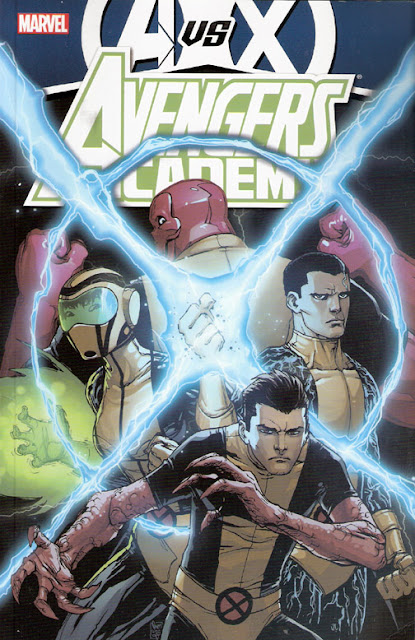Demon Knights, v. 2: The Avalon Trap
Collects: Demon Knights #0 and 8-12 (2012)
Released: May 2013 (DC)
Format: 144 pages / color / $14.99 / ISBN: 9781401240394
What is this?: Medieval heroes head to Camelot. Camelot? Camelot? Camelot! (It’s only an alternate version.)
The culprits: Writer Paul Cornell and artists Diogenes Neves and Bernard Chang
Following the fantasy protagonists’ defeat of an army in Demon Knights, v. 1: Seven against the Dark, the book’s seven heroes head to Alba Sarum to receive their reward in Demon Knights, v. 2: The Avalon Trap. Well, “reward”: it’s not so much compensation or perquisites as it is another mission. This time, the group is sent to Avalon to rescue the spirit of Merlin, who has been murdered in Alba Sarum.
So: fantasy quest. Writer Paul Cornell gives us Fantasy Quest #28b, the one with a crumbling castle, a trap, and a double cross; the “b” denotes the variant where the characters are given their fondest desires, but it come with a price. In truth, the quest is not as cookie cutter as I’m making it seem, but it does lack heft. The trap is set by the obvious culprit, and the trap itself lacks any subtlety or hint that it is anything but what it is. The double-cross comes from the person Cornell has already told readers is a double-crosser.
 The plot’s predictability isn’t Avalon Trap’s only weakness, however, and it isn’t even the plot’s only weakness. It story is also slow, with the quest creeping through a landscape filled with giant, distorted animals that are eventually shown to have little relevance to the villain's plan. And then there’s the question of Camelot and King Arthur …
The plot’s predictability isn’t Avalon Trap’s only weakness, however, and it isn’t even the plot’s only weakness. It story is also slow, with the quest creeping through a landscape filled with giant, distorted animals that are eventually shown to have little relevance to the villain's plan. And then there’s the question of Camelot and King Arthur …Three of Demon Knights’s protagonists were at Camelot when it fell: Jason Blood (who shares his body with Etrigan the Demon), Madame Xanadu, and Shining Knight. Jason and Xanadu were sweethearts, but they and Shining Knight have no knowledge of each other. To rectify that apparent contradiction, Cornell posits a multiplicity of Camelots and Arthurs. It solves the problem with the Shining Knight neatly, but it robs the fall of Camelot and the death of Arthur — the heart of the Arthurian legend — of some of its narrative heft. What does it matter that those characters’ Camelot fell? Camelot is always falling, Arthur is always dying and returning. Camelot is significant to the world of Demon Knights, but Camelot’s devastation and Arthur’s transformation in issues #9-12 aren’t a tragedy or even especially sad; each fallen Camelot is just a set with different dressing, starring a different actor as Arthur with a slightly different costume.
The ensemble approach to character development Cornell used in Seven Against the Dark is put aside in Avalon Trap in favor of an emphasis on Xanadu and Etrigan. Issue #8 goes into the history of their love triangle with Jason Blood, and #0 follows Etrigan’s rise through the demonic ranks. Given the large cast, concentrating on a few characters seems wise; Xanadu and Jason Blood / Etrigan are the book’s most recognizable characters, so starting with them makes sense. The other characters get only a few chances to shine; Al Jabr is distrustful of Vandal Savage, who gets the best lines (“I will not die so a woman with no face can gain different genitalia!”), and Shining Knight displays some impressive swordwork. Those moments do not dispel the “Etrigan, Madame Xanadu, and Friends” vibe Avalon Trap has, though.
A few notes strike me as false, even after suspending my disbelief. First, the characters use the British insult “swivers” a few times; the word is roughly from the right time, dating back to at least 1440, according to the Oxford English Dictionary. It means “someone given to sexual indulgence.” That doesn’t seem like much of an insult to characters like Etrigan or Vandal Savage, and the term looks self-consciously strange to Americans. Secondly, Alba Sarum is ruled by a pair of princesses who hope to marry each other. While royal lesbians surely existed, by the laws of averages at the very least, the medieval protagonists’ and townsfolk’s acceptance is strange. Stranger still is Xanadu’s thinly veiled plug for gay marriage.
Diogenes Neves provides most of the art, although on more than half his five issues he has to have an assist. Neves differentiates the characters well, and his storytelling is good. He draws some excellent monsters as well. However, the extent of the characters’ transformations in #11 is a bit unclear. Bernard Chang draws #0 and does a very good job as well. If only Marvel had demons as fearsome as the ones Chang draws!
The visuals aren’t enough to save Avalon Trap, though. The setting is disposable, the plot is slight, and most of the cast is underused. The promise of Demon Knight has faded; I don’t know if I’m going to pick up v. 3.
Rating:
Labels: 2, 2013 May, Al Jabr, Alba Sarum, Bernard Chang, Camelot, DC, Demon Knights, Diogenes Neves, Etrigan, Exoristos, Horsewoman, Jason Blood, Madame Xanadu, New 52, Paul Cornell, Shining Knight, Vandal Savage





